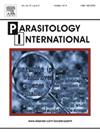尼日利亚先天性疟疾:系统回顾和荟萃分析
IF 1.9
4区 医学
Q3 PARASITOLOGY
引用次数: 0
摘要
先天性疟疾(CM),这是一种罕见的疾病,疟疾寄生虫在怀孕或分娩期间由母亲传染给孩子。世界卫生组织(世卫组织)强调,疟疾流行地区的母亲和新生儿更加容易受到伤害。为了评估尼日利亚CM的患病率,使用系统评价和荟萃分析首选报告项目(PRISMA)清单进行了系统评价和质量效应荟萃分析。研究选择、数据提取和方法学质量评估由两位研究者独立完成。检索PubMed、AJOL、b谷歌Scholar、Malaria Consortium Library和Web of Science等文献数据库,检索2000年1月至2024年12月报告新生儿先天性疟疾(0-7天)的已发表数据。从确定的483项研究中,35项研究包括9503名新生儿符合纳入标准。先天性疟疾的总患病率为12.7% (95% CI: 7.3-19.2),异质性较高(I2 = 97.3, Q = 1241.3, P < 0.0001)。先天性疟疾患儿平均寄生虫数为56.6/μl。同时伴有疟疾和败血症的新生儿占4.8%(3.4 - 6.7%)。母婴配对亚组分析显示,母体、胎盘、婴儿外周血和脐带血疟疾寄生虫病患病率分别为25.5%、20.3%、12.9%和11.1%。寄生儿产妇平均年龄29.05±4.3岁。这些发现强调了尼日利亚先天性疟疾的重大负担,对新生儿健康有潜在的不良后果。CM在流行地区仍然是一个重要的公共卫生问题。加强监测和有针对性的干预措施是减少慢性脊髓炎传播和改善健康结果的必要条件。本文章由计算机程序翻译,如有差异,请以英文原文为准。
Congenital malaria in Nigeria: A systematic review and meta-analysis
Congenital malaria (CM), a rare condition where malaria parasites are transmitted from mother to child during pregnancy or delivery. The World Health Organization (WHO) highlights the heightened vulnerability of both mothers and neonates in malaria-endemic regions. To assess the prevalence of CM in Nigeria, a systematic review and quality-effects meta-analysis were conducted using the Preferred Reporting Items for Systematic Reviews and Meta-Analyses (PRISMA) checklist. Study selection, data extraction, and methodological quality assessment were performed independently by two investigators. Literature databases, including PubMed, AJOL, Google Scholar, Malaria Consortium Library and Web of Science, were searched for published data between January 2000 and December 2024 reporting congenital malaria in neonates (0–7 days). From 483 studies identified, 35 studies comprising 9503 neonates met the inclusion criteria. The pooled prevalence of congenital malaria was 12.7 % (95 % CI: 7.3–19.2), with high heterogeneity (I2 = 97.3, Q = 1241.3, P < 0.0001). The average parasite count from neonates with congenital malaria was 56.6/μl. Neonates with both malaria and septicaemia were 4.8 % (3.4–6.7). Subgroup analyses of maternal‑neonate pairings revealed maternal, placental, baby peripheral and cord blood malaria parasitaemia prevalences of 25.5 %, 20.3 %, 12.9 %, and 11.1 %, respectively. The average maternal age of parasitaemic babies was 29.05 ± 4.3 years. These findings emphasise the significant burden of congenital malaria in Nigeria, with potential adverse outcomes for newborn health. CM remains a critical public health concern in endemic regions. Enhanced surveillance and targeted interventions are imperative to reduce CM transmission and improve health outcomes.
求助全文
通过发布文献求助,成功后即可免费获取论文全文。
去求助
来源期刊

Parasitology International
医学-寄生虫学
CiteScore
4.00
自引率
10.50%
发文量
140
审稿时长
61 days
期刊介绍:
Parasitology International provides a medium for rapid, carefully reviewed publications in the field of human and animal parasitology. Original papers, rapid communications, and original case reports from all geographical areas and covering all parasitological disciplines, including structure, immunology, cell biology, biochemistry, molecular biology, and systematics, may be submitted. Reviews on recent developments are invited regularly, but suggestions in this respect are welcome. Letters to the Editor commenting on any aspect of the Journal are also welcome.
 求助内容:
求助内容: 应助结果提醒方式:
应助结果提醒方式:


